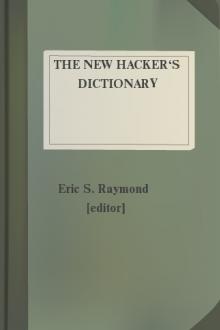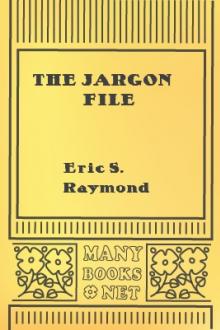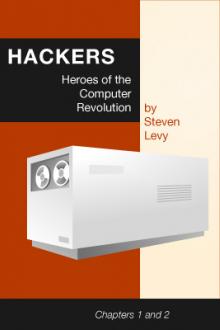The New Hacker's Dictionary by Eric S. Raymond (each kindness read aloud TXT) 📖

- Author: Eric S. Raymond
- Performer: 0262680920
Book online «The New Hacker's Dictionary by Eric S. Raymond (each kindness read aloud TXT) 📖». Author Eric S. Raymond
0011010, also called SUB or control-Z, was one common line-starve
character in the days before microcomputers and the X3.64 terminal
standard. Today, the term might be used for the ISO reverse line feed
character 0x8D. Unlike line feed',line starve' is not standard
[7983]ASCII terminology. Even among hackers it is considered a bit
silly. 3. [proposed] A sequence such as c (used in System V echo, as
well as [7984]nroff and [7985]troff) that suppresses a [7986]newline
or other character(s) that would normally be emitted.
Node:linearithmic, Next:[7987]link farm, Previous:[7988]line starve,
Up:[7989]= L =
linearithmic adj.
Of an algorithm, having running time that is O(N log N). Coined as a
portmanteau of linear' andlogarithmic' in "Algorithms In C" by
Robert Sedgewick (Addison-Wesley 1990, ISBN 0-201-51425-7).
Node:link farm, Next:[7990]link rot, Previous:[7991]linearithmic,
Up:[7992]= L =
link farm n.
[Unix] A directory tree that contains many links to files in a master
directory tree of files. Link farms save space when one is maintaining
several nearly identical copies of the same source tree -- for
example, when the only difference is architecture-dependent object
files. "Let's freeze the source and then rebuild the FROBOZZ-3 and
FROBOZZ-4 link farms." Link farms may also be used to get around
restrictions on the number of -I (include-file directory) arguments on
older C preprocessors. However, they can also get completely out of
hand, becoming the filesystem equivalent of [7993]spaghetti code.
Node:link rot, Next:[7994]link-dead, Previous:[7995]link farm,
Up:[7996]= L =
link rot n.
The natural decay of web links as the sites they're connected to
change or die. Compare [7997]bit rot.
Node:link-dead, Next:[7998]lint, Previous:[7999]link rot, Up:[8000]= L
=
link-dead adj.
[MUD] The state a player is in when they kill their connection to a
[8001]MUD without leaving it properly. The player is then commonly
left as a statue in the game, and is only removed after a certain
period of time (an hour on most MUDs). Used on [8002]IRC as well,
although it is inappropriate in that context. Compare [8003]netdead.
Node:lint, Next:[8004]Lintel, Previous:[8005]link-dead, Up:[8006]= L =
lint
[from Unix's lint(1), named for the bits of fluff it supposedly picks
from programs] 1. vt. To examine a program closely for style, language
usage, and portability problems, esp. if in C, esp. if via use of
automated analysis tools, most esp. if the Unix utility lint(1) is
used. This term used to be restricted to use of lint(1) itself, but
(judging by references on Usenet) it has become a shorthand for
[8007]desk check at some non-Unix shops, even in languages other than
C. Also as v. [8008]delint. 2. n. Excess verbiage in a document, as in
"This draft has too much lint".
Node:Lintel, Next:[8009]Linus, Previous:[8010]lint, Up:[8011]= L =
Lintel n.
The emerging [8012]Linux/Intel alliance. This term began to be used in
early 1999 after it became clear that the [8013]Wintel alliance was
under increasing strain and Intel started taking stakes in Linux
companies.
Node:Linus, Next:[8014]Linux, Previous:[8015]Lintel, Up:[8016]= L =
Linus /leen'us'/ or /lin'us'/, not /li:'nus/
Linus Torvalds, the author of [8017]Linux. Nobody in the hacker
culture has been as readily recognized by first name alone since Ken
(Thompson).
Node:Linux, Next:[8018]lion food, Previous:[8019]Linus, Up:[8020]= L =
Linux /lee'nuhks/ or /li'nuks/, not /li:'nuhks/ n.
The free Unix workalike created by Linus Torvalds and friends starting
about 1991. The pronunciation /lee'nuhks/ is preferred because the
name `Linus' has an /ee/ sound in Swedish (Linus's family is part of
Finland's 6% ethnic-Swedish minority). This may be the most remarkable
hacker project in history -- an entire clone of Unix for 386, 486 and
Pentium micros, distributed for free with sources over the net (ports
to Alpha and Sparc and many other machines are also in use).
Linux is what [8021]GNU aimed to be, and it relies on the GNU toolset.
But the Free Software Foundation didn't produce the kernel to go with
that toolset until 1999, which was too late. Other, similar efforts
like FreeBSD and NetBSD have been technically successful but never
caught fire the way Linux has; as this is written in 2000, Linux is
seriously challenging Microsoft's OS dominance. It has already
captured 31% of the Internet-server market and 25% of general business
servers.
An earlier version of this entry opined "The secret of Linux's success
seems to be that Linus worked much harder early on to keep the
development process open and recruit other hackers, creating a
snowball effect." Truer than we knew. See [8022]bazaar.
(Some people object that the name `Linux' should be used to refer only
to the kernel, not the entire operating system. This claim is a proxy
for an underlying territorial dispute; people who insist on the term
`GNU/Linux' want the the [8023]FSF to get most of the credit for Linux
because RMS and friends wrote many of its user-level tools. Neither
this theory nor the term `GNU/Linux' has gained more than minority
acceptance).
Node:lion food, Next:[8024]Lions Book, Previous:[8025]Linux,
Up:[8026]= L =
lion food n.
[IBM] Middle management or HQ staff (or, by extension, administrative
drones in general). From an old joke about two lions who, escaping
from the zoo, split up to increase their chances but agree to meet
after 2 months. When they finally meet, one is skinny and the other
overweight. The thin one says: "How did you manage? I ate a human just
once and they turned out a small army to chase me -- guns, nets, it
was terrible. Since then I've been reduced to eating mice, insects,
even grass." The fat one replies: "Well, I hid near an IBM office and
ate a manager a day. And nobody even noticed!"
Node:Lions Book, Next:[8027]LISP, Previous:[8028]lion food, Up:[8029]=
L =
Lions Book n.
"Source Code and Commentary on Unix level 6", by John Lions. The two
parts of this book contained (1) the entire source listing of the Unix
Version 6 kernel, and (2) a commentary on the source discussing the
algorithms. These were circulated internally at the University of New
South Wales beginning 1976-77, and were, for years after, the only
detailed kernel documentation available to anyone outside Bell Labs.
Because Western Electric wished to maintain trade secret status on the
kernel, the Lions Book was only supposed to be distributed to
affiliates of source licensees. In spite of this, it soon spread by
[8030]samizdat to a good many of the early Unix hackers.
[1996 update: The Lions book lives again! It was put back in print as
ISBN 1-57398-013-7 from Peer-To-Peer Communications, with forewords by
Dennis Ritchie and Ken Thompson. In a neat bit of reflexivity, the
page before the contents quotes this entry.]
Node:LISP, Next:[8031]list-bomb, Previous:[8032]Lions Book, Up:[8033]=
L =
LISP n.
[from LISt Processing language', but mythically fromLots of
Irritating Superfluous Parentheses'] AI's mother tongue, a language
based on the ideas of (a) variable-length lists and trees as
fundamental data types, and (b) the interpretation of code as data and
vice-versa. Invented by John McCarthy at MIT in the late 1950s, it is
actually older than any other [8034]HLL still in use except FORTRAN.
Accordingly, it has undergone considerable adaptive radiation over the
years; modern variants are quite different in detail from the original
LISP 1.5. The dominant HLL among hackers until the early 1980s, LISP
now shares the throne with [8035]C. Its partisans claim it is the only
language that is truly beautiful. See [8036]languages of choice.
All LISP functions and programs are expressions that return values;
this, together with the high memory utilization of LISPs, gave rise to
Alan Perlis's famous quip (itself a take on an Oscar Wilde quote) that
"LISP programmers know the value of everything and the cost of
nothing".
One significant application for LISP has been as a proof by example
that most newer languages, such as [8037]COBOL and [8038]Ada, are full
of unnecessary [8039]crocks. When the [8040]Right Thing has already
been done once, there is no justification for [8041]bogosity in newer
languages.
Node:list-bomb, Next:[8042]lithium lick, Previous:[8043]LISP,
Up:[8044]= L =
list-bomb v.
To [8045]mailbomb someone by forging messages causing the victim to
become a subscriber to many mailing lists. This is a self-defeating
tactic; it merely forces mailing list servers to require confirmation
by return message for every subscription.
Node:lithium lick, Next:[8046]little-endian, Previous:[8047]list-bomb,
Up:[8048]= L =
lithium lick n.
[NeXT] Steve Jobs. Employees who have gotten too much attention from
their esteemed founder are said to have `lithium lick' when they begin
to show signs of Jobsian fervor and repeat the most recent catch
phrases in normal conversation -- for example, "It just works, right
out of the box!"
Node:little-endian, Next:[8049]live, Previous:[8050]lithium lick,
Up:[8051]= L =
little-endian adj.
Describes a computer architecture in which, within a given 16- or
32-bit word, bytes at lower addresses have lower significance (the
word is stored `little-end-first'). The PDP-11 and VAX families of
computers and Intel microprocessors and a lot of communications and
networking hardware are little-endian. See [8052]big-endian,
[8053]middle-endian, [8054]NUXI problem. The term is sometimes used to
describe the ordering of units other than bytes; most often, bits
within a byte.
Node:live, Next:[8055]live data, Previous:[8056]little-endian,
Up:[8057]= L =
live /li:v/ adj.,adv.
[common] Opposite of `test'. Refers to actual real-world data or a
program working with it. For example, the response to "I think the
record deleter is finished" might be "Is it live yet?" or "Have you
tried it out on live data?" This usage usually carries the connotation
that live data is more fragile and must not be corrupted, or bad
things will happen. So a more appropriate response might be: "Well,
make sure it works perfectly before we throw live data at it." The
implication here is that record deletion is something pretty
significant, and a haywire record-deleter running amok live would
probably cause great harm.
Node:live data, Next:[8058]Live Free Or Die!, Previous:[8059]live,
Up:[8060]= L =
live data n.
Data that is written to be interpreted and takes over program flowwhen triggered by some un-obvious operation, such as viewing it. One
use of such hacks is to break security. For example, some smart
terminals have commands that allow one to download strings to program
keys; this can be used to write live data that, when listed to the
terminal, infects it with a security-breaking [8061]virus that is
triggered the next time a hapless user strikes that key. For another,
there are some well-known bugs in [8062]vi that allow certain texts to
send arbitrary commands back to the machine when they are simply
viewed. 2. In C code, data that includes pointers to function
[8063]hooks (executable code). 3. An object, such as a
[8064]trampoline, that is constructed on the fly by a program and
intended to be executed as code.
Node:Live Free Or Die!, Next:[8065]livelock, Previous:[8066]live data,
Up:[8067]= L =
Live Free Or Die! imp.
The state motto of New Hampshire, which appears on that state'sautomobile license plates. 2. A slogan associated with Unix in the
romantic days when Unix aficionados saw themselves as a tiny,
beleaguered underground tilting against the windmills of industry. The
"free" referred specifically to freedom from the [8068]fascist design
philosophies and crufty misfeatures common on competing operating
systems. Armando Stettner, one of the early Unix developers, used to
give out fake license plates bearing this motto under a large Unix,
all in New Hampshire colors of green and white. These are now valued
collector's items. In 1994 [8069]DEC put an inferior imitation of
these in circulation with a red corporate logo added. Compaq (half of
which was once DEC) has continued the practice.
Node:livelock, Next:[8070]liveware, Previous:[8071]Live Free Or Die!,
Up:[8072]= L =
livelock /li:v'lok/ n.
A situation in which some critical stage of a task is unable to finish
because its clients perpetually create more work for it to do after
they have been serviced but before it can clear its queue. Differs
from [8073]deadlock in that the process is not blocked or waiting for
anything, but has a virtually infinite amount of





Comments (0)